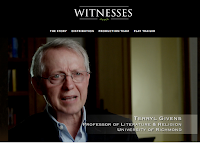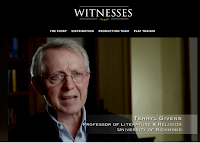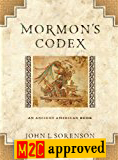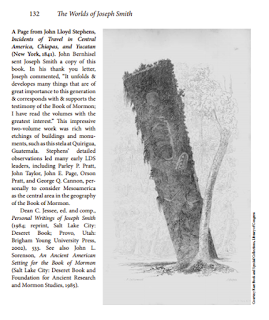https://bookofmormonconsensus.blogspot.com/2019/06/conformity-power-of-social-influences.html
Below I discuss Kno-Why #521 from Book of Mormon Central (BMC), a discussion of Book of Mormon witnesses that may be the most astonishing piece they’ve published so far. We love all the people at BMC, but seriously, they’re the last ones people should listen to regarding the witnesses.
Not coincidentally, BMC employees and affiliates are also working on the upcoming movie on the Witnesses produced by the Interpreter Foundation, which you can read about here: https://witnessesfilm.com/
The Kno-Why tries to support the testimonies of the Book of Mormon witnesses, which, presumably, is also the purpose of the film. We can all agree that’s a fine objective.
Here’s the problem.
BMC (and the Interpreter Foundation) want people to believe some, but not all, of what the witnesses said.
These are the least credible organizations imaginable to support the testimonies of the Book of Mormon witnesses.
If the intellectuals at BMC and the Interpreter agree with what the witnesses said, you’re supposed to believe the witnesses. But if the intellectuals at BMC and the Interpreter disagree with what the witnesses said, you’re supposed to believe the intellectuals instead of the witnesses.
None of this is surprising to those who read the material produced by the M2C citation cartel.
| Trailer for Witnesses movie, featuring Terryl Givens, M2C promoter and author of Foreword to Mormon’s Codex |
– BMC and the Interpreter Foundation promote M2C (the Meosamerican/two Cumorahs theory).
– The first principle of M2C is the claim that the Three Witnesses were unreliable whenever they spoke or wrote about the New York Cumorah.
– None of the M2C intellectuals believe what the Three Witnesses said when the witnesses’ statements contradict M2C; i.e., these intellectuals believe M2C more than the Three Witnesses.
| Trailer for Witnesses movie, featuring Matt Roper, M2C promoter and employee of Book of Mormon Central |
– The arguments made by the M2C intellectuals to justify disbelieving what the Three Witnesses said about Cumorah are the identical arguments made by the critics to justify disbelieving everything the Three Witnesses said.
Just watch the trailer for the Witnesses movie and you’ll how the M2C intellectuals discuss the witnesses. We can be sure they’re not going to tell the public what the witnesses said about the New York Cumorah.
_____
Reading this Kno-Why reminds me of a larger point.
I don’t understand why some members of the Church give so much deference to scholars. It borders on reverence in some cases. Respect is fine–we respect everyone, ultimately–but I keep hearing people quoting scholars as authority for one thing or another.
These scholars are just people doing their jobs.
Unlike ordinary members such as you and I, these scholars are paid to study the scriptures and “interpret” them. Many are paid to teach the youth in the Church. We can assume they are all great people, devoted, faithful, committed, etc. Every one of them I have spent time with is awesome, exemplary, etc., so I vouch for their character (if not their ideas).
There are a lot of LDS scholars who work in a variety of fields, but here I’m mainly referring to the M2C intellectuals and revisionist historians, along with their followers and employees. Most are supported by tithing funds (BYU, CES, COB) or other donations and have a much higher standard of living than most members of the Church around the world who pay that tithing. Some brag about their world travels, close relationships with the Brethren, etc. As Gershwin wrote, nice work if you can get it.
To be clear, I appreciate and respect the work they do. I use their material all the time and encourage others to do the same. I consider their views and biases, but I certainly don’t defer to their interpretations or ideas.
Consider their work as a tool, like your phone. I use my phone all the time, but I don’t defer to the philosophies of the people who invented, designed, manufactured, shipped and marketed the phone. The phone is a useful implement, just like the materials produced by LDS (or other) scholars.
The Joseph Smith Papers, for example, are awesome. But the notes often reflect the interpretations, biases, and ideas of the revisionist and M2C scholars. Focus on the documents. You can take or leave the notes.
I think the scriptures and the gospel are for everyone. You don’t need an expert to tell you what the scriptures teach. And you really don’t need an expert who tries to persuade you that the prophets are wrong.
President Ballard made this point at BYU when he said:
That’s great advice, so long as we first ask, what questions require an expert?
Does it require an expert to read and understand the scriptures? To read and understand Letter VII? To read and understand the consistent and persistent teachings of the prophets about the New York Cumorah?
Of course not.
_____
Someone sent me a link to the latest Kno-Why from BMC that I referenced above. Here’s the link.
You have to read it for yourself to appreciate the irony.
This Kno-Why is astonishing because the strongest attacks on the credibility of the Three Witnesses come directly from within the Church–from the M2C citation cartel, including Book of Mormon Central, the Interpreter, Fairmormon, and the rest.
Everyone expects critics of the Church to disbelieve the witnesses. That’s axiomatic; if they didn’t disbelieve the witnesses, they’d believe them. Presumably they’d accept the Book of Mormon (whether or not they join any church).
The Kno-Why goes through the usual list of statements and arguments. Of course, none of it is persuasive. There’s enough evidence to support whatever you want to think about the witnesses. That’s basic psychology. People see only evidence that confirms their biases; they are blind to evidence that contradicts their biases.
Here’s what makes this Kno-Why so amazing.
The entire foundation of M2C rests on the claim that the Three Witnesses were unreliable!
For example, BMC’s footnote 14 refers to David Whitmer’s interview with Joseph F. Smith about David’s experience with the plates. BMC cites this as a reason to believe David Whitmer. But that same interview included his statement about the messenger going to Cumorah, a statement that BMC rejects!
When I was returning to Fayette with Joseph and Oliver all of us riding in the wagon, Oliver and I on an old fashioned wooden spring seat and Joseph behind us, while traveling along in a clear open place, a very pleasant, nice-looking old man suddenly appeared by the side of our wagon who saluted us with, “good morning, it is very warm,” at the same time wiping his face or forehead with his hand. We returned the salutation, and by a sign from Joseph I invited him to ride if he was going our way. But he said very pleasantly, “No, I am going to Cumorah.’ This name was something new to me, I did not know what Cumorah meant. We all gazed at him and at each other, and as I looked round enquiringly of Joseph the old man instantly disappeared, so that I did not see him again.
[BTW, if you go to the link provided by BMC, it goes to a resource at BYU that omits three pages, including the page containing David’s statement about Cumorah that I quoted above. You can see the entire interview here:
http://jared.pratt-family.org/report-of-elders-orson-pratt-and-joseph-f-smith.html
_____
Here is a partial list of statements from the Three Witnesses that BMC wants people to disbelieve.
BMC expressly rejects what President Cowdery wrote about Moroni and Cumorah in Letters IV, VII, and VIII.
BMC expressly rejects Oliver Cowdery’s statement to the Indians that Moroni himself called the hill in New York Cumorah anciently.
BMC expressly rejects Oliver Cowdery’s statements that he and Joseph visited the depository of Nephite records in the Hill Cumorah on multiple occasions.
BMC expressly rejects David Whitmer’s testimony about the messenger he met on the road to Fayette who was taking the Harmony plates to Cumorah.
BMC expressly rejects David Whitmer’s testimony that Oliver told him about visiting the Nephite depository in Cumorah.
BMC expressly rejects David Whitmer’s testimony that the plates are no longer in Cumorah but are not far from there.
BMC expressly rejects Martin Harris’s statement that only he, David, Oliver and Joseph ever saw the plates that were kept in the wooden box.
I could go on, but you see the point.
Plus, of course, BMC expressly rejects the teachings of any prophet and apostle who has publicly supported the testimony of these witnesses about the New York Cumorah.
All of these statements have been published, but BMC censors them (except when they’re justifying their disbelief in them).
Contrast that to what the Kno-Why says:
When viewed collectively, the witnesses’ published testimonies are favored by “an overwhelming preponderance of evidence.” Each of the relevant first-hand statements from members of the Three and Eight Witnesses reaffirm their original statements. In addition, the majority of second-hand or hearsay accounts of the witnesses’ statements—from friends, critics, and neutral observers alike—also support the witnesses published testimonies.
That point is just as true about the witnesses’ statements about the New York Cumorah as it is about their statements about the plates.
BMC has zero credibility when it comes to supporting the testimony of the Three Witnesses. Why does anyone pay them any attention at all?
One good thing might come out of this Kno-Why.
Maybe people who actually read it will recognize that Book of Mormon Central has just completely destroyed their own arguments against the credibility of the witnesses.
_____
Speaking of LDS intellectuals…
I’m told Dan Peterson–a wonderful, faithful, smart, and all-around great guy– has been complaining about my criticism of the Interpreter. Maybe someday I’ll read what he has to say, but it doesn’t matter because he has had emotional reactions like this for decades, from the FARMS days through the present. He’s taken what he perceives to be a lot of arrows for what he perceives to be his defense of the Church. If he has a problem, I’m always available for a meeting. I’ve never turned down an invitation to meet with any of the M2C intellectuals, but Dan has declined my invitation to meet. Now he’s producing the Witnesses film through the Interpreter Foundation. We can be confident he’s not going to allow viewers to know what the witnesses said about the New York Cumorah.
Then we have Book of Mormon Central, which is pretty much the same story. I’m told one of their employees is also complaining about my criticism of M2C, but that doesn’t matter, either. He’s just another employee doing a job. His bosses insist the witnesses and the prophets are wrong about the New York Cumorah because of M2C, so he’s doing everything he can to support M2C. I have no problem with that.
In fact, I when I was his age, if I had been working for Book of Mormon Central, I probably would have done the same thing. Back then, I, too, had been persuaded to believe M2C. Fortunately, we all have chances to learn and grow.
Well, then we have Dan, still reacting the same way he’s been doing for years…
The one thing I wouldn’t have supported as an employee of Book of Mormon Central is the organization’s ongoing censorship of alternatives to M2C.
Censorship is a normal practice among those who are insecure about their own positions, but it is surprising that in today’s world, anyone in a free country supports censorship. Fortunately, censorship is a losing strategy in the long run.
I’ve noticed some very strange characteristics of M2C intellectuals. I don’t mean to generalize, but in most cases, the M2C intellectuals are hyper-defensive. They view debates about facts and logic as if they were personal. They have a strong “us vs. them” mentality, sort of a siege mentality, as if it is them against the world. They get angry a lot.
From my perspective, those are all characteristics of uncertainty and insecurity.
Another attribute, the claim that they are hired by the prophets to guide the Church, may be a factor. Those who actually believe this would naturally be hyper-defensive. Those who deny the M2C scholars think this way don’t know what their employees have said.
None of this matters to those of us who don’t defer to these scholars. Which, hopefully, is the approach most people take.
We’re confident and happy, with no animosity or anger toward anyone. We’re happy to exchange views. We freely refer people to the M2C citation cartel publications and websites. We want people to know what they’re teaching.
Really, the only thing we oppose is censorship.
_____
For anyone interested in knowing more about the M2C psychology from an academic perspective, there’s a nice article on motivated reasoning here:
https://judithcurry.com/2019/06/19/climate-scientists-motivated-reasoning/





